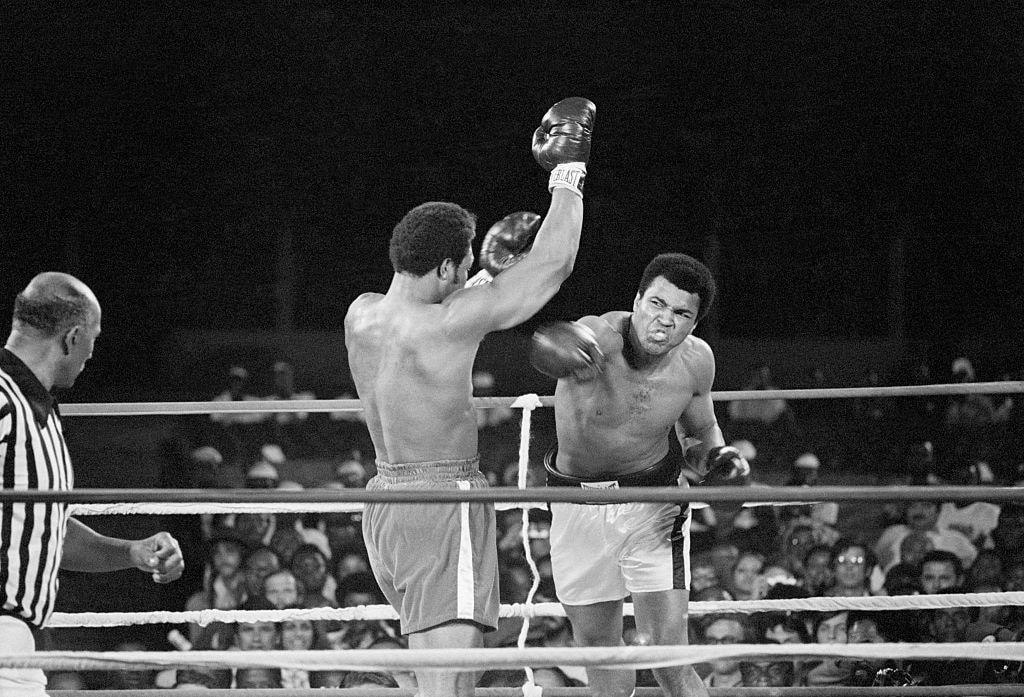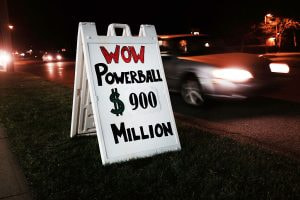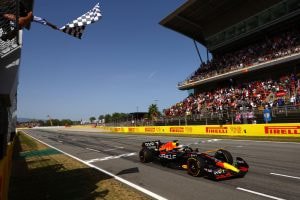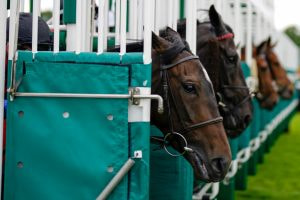Six of Sports’ Greatest Head-To-Head Battles Remembered
“Sports is something that transcends generations, transcends backgrounds, cultures, races. And so, the power of sports is real,” said NFL star Malcolm Jenkins a few months after winning his second Super Bowl ring in 2017. Jenkins’ wisdom belied his years. Born in 1987, the star was not even alive when five of our six most memorable sporting duels happened.
From Arkle’s epic battle with Mill House in the 1964 Cheltenham Gold Cup to Hamilton versus Verstappen in the concluding race of the 2021 Formula 1 season – not forgetting Alydar’s rivalry with Affirmed and Borg versus McEnroe during a golden period for tennis. The list of outstanding sporting showdowns is long.

Muhammad Ali and George Foreman’s ‘Rumble in the Jungle’ is often described as “the greatest sporting event of the 20th century”. ©GettyImages
Here, in no particular order, three famous horse races, a classic greyhound showdown, a controversial Olympic event and a vintage performance from Muhammad Ali are remembered. These enduring confrontations can be enjoyed through grainy YouTube footage, but this is the story behind them.
When Ali Said Welcome to the Jungle
The ‘Rumble in the Jungle’ was a momentous fight that more than lived up to its hype. Today, it is considered one of the greatest sporting events ever. Perhaps more than anything, it should be remembered as the fight that secured Muhammad Ali’s status as one of the biggest stars in the sport’s history.
In February 1964, Muhammad Ali, then called Cassius Clay, defied bookmaker odds of 7/1 to beat Sonny Liston. It was the fighter’s 20th straight victory, and he would remain unbeaten until March 1971, when Joe Frazer claimed his title. There would be a second loss – to Ken Norton – in 1973.
Nevertheless, despite his 33rd birthday approaching, Ali had a shot at regaining his World title in 1974. His rival was George Foreman – eight years Ali’s junior and unbeaten in 40 professional fights. Foreman had claimed the World title in 1973 by beating Joe Frazier and had already defended it twice, most recently knocking out Ken Norton in two rounds.
The contest, famously known as the ‘Rumble in the Jungle’ because it happened in the Democratic Republic of the Congo, was believed to have been watched by a billion television viewers. It grossed an estimated $100 million (inflation-adjusted $600 million) in worldwide revenue.
The history books show Ali, priced on 4/1 by the boxing bookmakers, successfully employed a strategy he famously called ‘rope-a-dope’ to exhaust Foreman. It allowed Ali to beat his younger but tiring rival by knockout in the eighth round.
Grundy Busted Them All in Greatest King George
Ascot’s King George VI and Queen Elizabeth Stakes is Britain’s most prestigious open-age flat race, and its 1975 edition was a crackerjack of a contest – described, afterwards, as the ‘Race of Century’. The field included dual King George heroine Dahlia, Irish Oaks winner Dibidale and German champion Star Appeal – who would land the Prix de l’Arc Triomphe later in the season.
However, Grundy, the winner of that year’s English and Irish Derby and Bustino – the 1973 St Leger winner who had broken the course record when taking Epsom’s Coronation Cup at the start of the summer – dominated proceedings.
Two pacemakers ensured this contest was run at a suicidal pace, and Bustino, under Joe Mercer, went for home with four furlongs to race. Grundy, the mount of Pat Eddery, caught Bustino with a furlong to run and withheld a spirited counterattack by his rival to win by half-a-length.
Grundy stopped the clock at two minutes and 26.9 seconds. It obliterated the race record by almost two-and-a-half seconds and was six seconds faster than the time Dahlia recorded when winning the race a year earlier. Not until 2009 was the winning time bettered in a King George.
The duel left its scars on both horses; Grundy raced just once more race, finishing well beaten in the Benson & Hedges Gold Cup at York – behind three rivals he trounced in the King George VI and Queen Elizabeth Stakes. Bustino never ran again and was retired to stud.
Bob Beats the Champ in Wembley Showdown
Ballyregan Bob had won 19 straight races, breaking eight track records. His aggregate winning distance of his previous six starts was 80 lengths. Scurlogue Champ was an enigmatic marathon star who had broken 17 track records at 14 different tacks.
It was a promoter’s dream, a heavyweight match between two titans of the sport. Unsurprisingly, renowned London greyhound bookmaker John Power seized the opportunity to sponsor the first and only meeting of these two great greyhounds. It happened at Wembley in December 1985.
80’s greyhound legends, Ballyregan Bob and Scurlogue Champ pic.twitter.com/rTynwLSTSq
— Sports & Betting History by BestBettingSites (@CDCHistory) April 7, 2018
Scurlogue Champ was a crowd-pleaser who would tail himself off on the first lap of his eight-bend marathon races and storm through the field on the second circuit to win in style. Such was his unique running style and popularity, his connections were paid appearance money as ‘The Champ’ would bring thousands through the turnstiles. He was a travelling circus.
Eight thousand greyhound fans and London TV cameras descended on Wembley Stadium to see the people’s favourite race against the connoisseurs’ choice, Ballyregan Bob. Alas, this ‘John Power Showdown’ did not match its hype.
In the event, the six-bend 710-metre journey against three top-notch rivals proved too much for Scurlogue Champ. There was no trademark last-to-first surge on the final circuit as he was quickly unsighted from his rivals and pulled himself up after galloping around just two bends.
Ballyregan Bob led from the outset and duly won the contest by almost a dozen lengths, breaking yet another track record. Twelve runs and 49 weeks later, the Hove-trained greyhound entered the Guinness Book of Records with a 32-race unbeaten streak that made him a world record holder. He was immediately retired and whisked off to stud.
The ‘Champ’ would revert to marathon races and quickly regain the winning thread. He broke three more track records after his ‘John Power Showdown’ disappointment and eventually retired as the winner of 51 races from 63 starts. He was the bookmakers betting favourite in all but three of his starts – including the defeat by Ballyregan Bob.
Crisp and Red Rum in the Greatest Grand National
Red Rum’s exploits in the Grand National – when the circuit was genuinely terrifying – can never be underestimated. The former flat racer, trained by a car salesman, won the Aintree showpiece three times and finished second twice. He also landed the Scottish Grand National and 21 other races during his remarkable career.
Red Rum’s first National triumph came in 1973. It was a strong rendition of the race with two-time Cheltenham Gold Cup winner L’Escargot in the field. Crisp, an Australian super-star who had won the Queen Mother Champion Chase at the Cheltenham Festival, was also in opposition.
Crisp, shouldering 23 pounds more than Red Rum as joint top weight, took up the running when clearing Becher’s Brook on the first circuit, and he led the field a merry dance. Ridden by Richard Pitman, the pair were 30 lengths clear at one point and, jumping the final fence, they were still 15 lengths ahead of the pursuing Red Rum.
A combination of Crisp’s petrol running out and Red Rum’s remarkable stamina saw Crisp collared in the shadow of the post. The frenetic pace set by Crisp meant the race was won in a record time of nine minutes and two seconds. Franking the form was L’Escargot. He was beaten 25 lengths into third but would win the Grand National two years later.
In a 2020 interview, Pitman said: “It was elation turned to desolation and then back to elation very quickly because I had had a thrill of a lifetime and money couldn’t buy what I experienced. Two from home, I thought he was still going to win as I had him held, and he was still going for me at that point. It was like when you’re a kid running away from a monster in your nightmares while stuck in treacle.”
Barefoot Budd Floors Mary Decker
Athletics has never and will never be a mainstream betting sport. However, such was the hype surrounding American poster girl Mary Decker meeting the barefoot running South African Zola Budd – who had controversially been fast-tracked British citizenship, allowing her to represent Great Britain in the 3000 metres at the 1984 Olympic Games – that UK bookies reported record turnover on an Olympic event.
Groups supporting the abolition of apartheid campaigned vociferously and effectively to highlight the special treatment Budd had received from UK authorities. The naturalisation process usually took years. For Budd, her change of citizenship was vital, as South African athletes were banned from international competition.
Budd made it to the Los Angeles games. As the reigning World Champion and multiple world record holder at many distances, Decker was the darling of the host nation. But, in the event, neither would take a medal of any colour in the 3000 metres final – it was a contest that would become one of the most talked about races in athletics history.
August 11, 1984. 12 athletes lined up for the women’s 3,000m at the Los Angeles Olympic Games – but this was always a two-person race: 26-year-old Mary Decker, blonde darling of Team USA against 18-year-old Zola Budd, a shy South African prodigy who ran without shoes. Neither won pic.twitter.com/NF4EIEyNLp
— Sports & Betting History by BestBettingSites (@CDCHistory) February 18, 2018
As Athletics Weekly wrote 41 years after the event: “A combination of Zola’s wide-arm action, hesitation to surge into a firm lead, and Mary’s reluctance to concede pole position was a recipe for disaster. First, there was a small clash when Mary’s knee nudged against Zola’s left leg, which should have acted as a warning. Five strides later, at 1,730m into the race, there was a far bigger one as the runners collided with more disastrous consequences.”
“Struggling to keep her balance, Zola’s pencil-thin left leg flicked out sideways, tangling with Mary’s right leg, and the American stumbled as if she had caught her feet on a trip wire, plunging forward violently with a thud onto the grass on the inside of the track. Around the arena, spectators gasped in horror. In the press seats, hundreds of journalists yelled in unison, “She’s down!” in a dozen different languages.”
Decker was down and out. “Then the booing started,” Athletics Weekly’s story continues. “Zola had grown accustomed to pockets of the crowd shouting anti-apartheid abuse at her, but this was on an entirely different scale. The whole stadium, it seemed, began to direct its fury toward the barefoot Briton as a cascade of whistles and boos rained down from the stands.”
Budd wrote in the Daily Mail a few days later: “I couldn’t believe it. It was terrible. I wanted to stop. I wanted it all to end. And, in truth, the race for me was really over. Instinctively, I kept on running. When you’ve trained for thousands of miles, you don’t just quit.”
The tiny, shy South African born athlete trailed in seventh, and Maricica Puica of Romania – one of the few Eastern Bloc countries that took part in the 1984 Olympics – eventually won the race at bookmaker odds of 7/1. Such was the hype surrounding Budd and Decker, it was missed by many that Puica had set the fastest time of the season and a new Olympic record in the heats.
Britain’s second representative, Wendy Sly, took the silver medal landing odds of 100/1 for each-way players. Nevertheless, Britain’s bookmakers, with the two favourites attracting all the money but finishing unplaced, reported the event as a “scoop”.
The Duel on the Downs
The 2011 running of the Sussex Stakes at Glorious Goodwood was labelled ‘The Dual on the Downs’. Its billing was a result of the undefeated three-year-old Frankel meeting the leading older miler Canford Cliffs, who had won his last five outings: the Group-1 Irish 2000 Guineas, the St James’s Palace Stakes, Sussex Stakes, Lockinge and Queen Anne.
Frankel, the 8/13 favourite in this four-runner contest, had been named Champion Two-year-old Colt of 2010 following success in the Royal Lodge Stakes and the Dewhurst. As a three-year-old, he had stretched his unbeaten sequence to seven by taking the Greenham Stakes at Newbury, the 2000 Guineas in breath-taking fashion, and then the St James’s Palace Stakes at Royal Ascot.
In the event, Frankel bounced out the stalls and made all to win with authority. He would race on for another 15 months, taking six more victories, retiring a 14-time-raced unbeaten legend and later becoming champion sire. Frankel’s beloved trainer, Henry Cecil, died less than two years later. Canford Cliffs never raced again.
The ‘Duel on the Downs’ possibly failed to meet its hype, but boxing-match-type face-offs remain incredibly rare in the world of flat racing. The brilliance of Frankel on this day – the first time he had met older rivals – is unforgettable, and this was one of his greatest victories.



